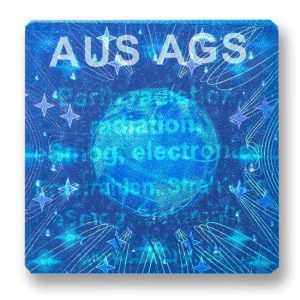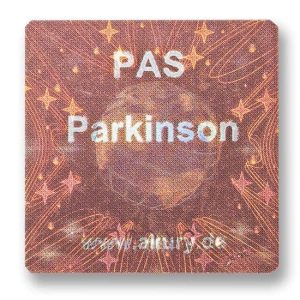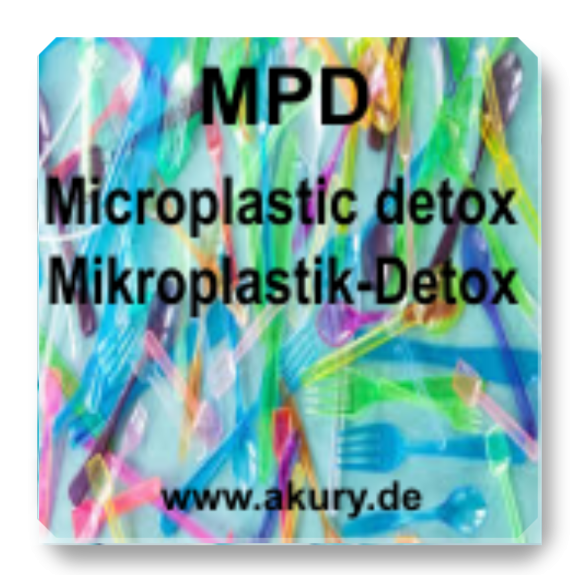MPD – Microplastic detox
Product description
Microplastics in the body: accumulation and health effects
Accumulation of microplastics in the body
Microplastics, i.e. plastic particles smaller than 5 mm, enter the human body in various ways:
- Ingestion via the food chain: Microplastics accumulate in marine organisms such as fish and shellfish that are consumed by humans. These particles thus enter the digestive tract.
- Drinking water and beverages: Tap water, bottled water, and other beverages may contain microplastics, particularly from plastic packaging or environmental pollution.
- Inhalation: Microplastic particles in the air, for example from worn tires, textiles, or plastic waste, can enter the lungs via the respiratory tract.
- Skin contact: Cosmetics or care products containing microplastics can be absorbed through the skin, although this occurs to a lesser extent.
Microplastic particles can accumulate in the following places in the body:
- Digestive system: Studies show that microplastics can remain in the gastrointestinal tract. Some are excreted, but smaller particles (< 150 µm) can pass through the intestinal wall and enter the bloodstream.
- Bloodstream and organs: Nanoparticles (particles < 1 µm) can be transported via the blood to organs such as the liver, kidneys, or spleen. There is evidence that they can even cross the blood-brain barrier.
- Lungs: Inhaled particles can settle in the lungs, especially in the alveoli, where they can cause inflammation.
- Placenta: Recent studies suggest that microplastics can reach the placenta of pregnant women and potentially be transferred to the fetus.
Health effects
The health consequences of microplastics have not yet been fully researched, but there are indications of potential risks:
- Inflammatory reactions: Microplastics can cause oxidative stress and inflammation in the body, especially in the lungs and digestive tract. This can contribute to chronic diseases.
- Toxic effects: Microplastics can adsorb pollutants such as heavy metals, pesticides, or plasticizers, which are released in the body and can cause cell damage.
- Immune system disruption: Particles can activate or weaken the immune system, which could increase susceptibility to disease.
- Hormonal disruption: Chemicals in microplastics, such as bisphenol A (BPA), can act as endocrine disruptors and interfere with the hormone system.
- Long-term risks: There are concerns that the accumulation of microplastics in organs could lead to long-term damage, such as cancer or liver disease, although long-term studies are still lacking.
Conclusion
Microplastics are ubiquitous and enter the human body through various routes, where they can accumulate in organs, tissues, and even the placenta. The health effects range from inflammation to potential hormonal disruption, but the exact long-term consequences are still unclear. Measures such as reducing plastic waste and stricter regulations could help reduce exposure.
AkuRy information chips: Support for the elimination of microplastics
Based on the principles of AkuRy chips, which transmit biological information through invisible vibrations and frequencies, specific chips such as the MPD (microplastic detox chip) or similar variants can support the elimination of microplastics from the organism. These chips work via resonance to stimulate biochemical processes that help the body detoxify and eliminate toxins. The following explains how they work biochemically and preventively.
Biochemical reactions during the elimination of microplastics
Microplastic particles that accumulate in the body can be perceived as foreign bodies or toxins. AkuRy chips send targeted frequencies that resonate with the body’s natural vibrations and trigger biochemical cascades to break down or excrete these particles:
Activation of liver and kidney enzymes: The MPD chip transmits frequencies that stimulate liver cells to activate enzymes such as cytochrome P450. These enzymes not only break down chemical toxins, but can also help process microplastic particles by breaking them down into smaller, excretable fragments. Similarly, kidney cells are stimulated to enhance filtration processes, leading to increased excretion via urine. Measurable: Blood tests show reduced toxin levels, including potential microplastic residues.
- Immune system support and inflammation reduction: Frequencies from the chips can epigenetically influence genes responsible for anti-inflammatory enzymes such as superoxide dismutase (SOD). This reduces oxidative stress caused by microplastics and activates macrophages (immune cells) that phagocytose (eat) and break down particles. Example: In quantum biology, these vibrations act at the cellular level to stabilize cell membranes, making it more difficult for microplastics to penetrate or adhere. Psychologically noticeable: Less fatigue and increased well-being, physically measurable by lower inflammation markers in the blood (e.g., CRP levels).
- Support for the digestive system: Chips such as the MPD chip synchronize the rhythm of the intestines (peristalsis), which accelerates excretion via the stool. Frequencies stimulate the production of bile acids, which can bind and excrete microplastic particles. This triggers a chain reaction: increased enzyme activity (e.g., lipases) breaks down particles, and the body excretes them more naturally. Noticeable: Improved digestion and more energy, measurable by stool tests for reduced particle residues.
- Hormonal and neural effects: Resonance promotes hormones such as glutathione (an antioxidant), which repairs cell damage caused by microplastics. In the brain, chips can calm brain waves (e.g., theta waves), which indirectly supports the entire detoxification process, as stress hinders elimination.
Important note: The effect is based on resonance and is individual, as the body only absorbs what it needs. There are no complete studies specifically on microplastics and AkuRy chips, but analogous to detox effects (e.g., fewer toxins in the blood), support is plausible.
Preventive effect of AkuRy chips
AkuRy chips work not only reactively, but also preventively by making the body more resistant to the absorption and accumulation of microplastics:
- Harmonization of environmental influences: Chips such as the eProtect chip emit frequencies (e.g., similar to the Schumann resonance, 7.83 Hz) that neutralize electrosmog and other environmental vibrations that could weaken the cell barrier. This prevents microplastics from penetrating cells more easily. Preventive: Wear the chip when exposed to plastic-containing products (e.g., on water bottles) to minimize absorption. Measurable: More stable brain waves (EEG) and less oxidative stress.
- Epigenetic prevention: Positive signals “switch off” genes that are prone to inflammation and “switch on” those that strengthen protective mechanisms. Example: Regular use of the detox chip trains the body to activate enzymes in advance so that elimination begins immediately upon contact with microplastics. Noticeable: Long-term increase in vitality and resilience.
- Rhythm stabilization: Chips support natural body rhythms (e.g., heart rate variability), which strengthens the immune system and improves the barrier function of the skin, lungs, and intestines. Preventive: Stick chips on devices or wear them to reduce daily exposure (e.g., through inhalation).
In summary, AkuRy chips promote the elimination of microplastics through biochemical activation of enzymes and immune processes, while also acting preventively by harmonizing and protecting the body. The effects are physically measurable (e.g., blood values) and psychologically noticeable (e.g., more energy), but these are complementary measures without any promise of healing.
AkuRy Information Chips: Protecting the Blood-Brain Barrier and Freeing the Brain from Microplastics
Studies have shown that micro- and nanoplastics can penetrate the blood-brain barrier (BBB), leading to accumulation in the brain and potential neurotoxic effects. Based on the principles of AkuRy chips, which use frequencies and vibrations to influence biological processes, specific chips such as the eProtect chip or the MPD chip can help prevent this and reduce existing accumulations. The effect is achieved through resonance, quantum biology, and epigenetic mechanisms, although there are no specific scientific studies on this—the explanations are based on the general functioning of the chips.
Preventive effect: Preventing the blood-brain barrier from being overcome
The blood-brain barrier is a protective barrier that shields the brain from harmful substances, but nanoplastics can pass through it due to their size and surface properties. AkuRy chips aim to prevent this by strengthening the integrity of the BBB and hindering the absorption of microplastics:
- Stabilization of cell membranes and endothelial cells: The eProtect chip emits frequencies (e.g., similar to the Schumann resonance at 7.83 Hz) that harmonize the endothelial cells of the BBB. These cells form the barrier and can be strengthened by resonance, making their tight junctions denser. This prevents nanoplastics particles from slipping through. In quantum biology, these vibrations act at the atomic level to balance cell polarity and reduce oxidative damage that could weaken the BBB.
Preventive: Stick the MPD chip on devices or wear it on your body to neutralize environmental influences such as electrosmog that could increase BBB permeability. Measurable: More stable brain waves via EEG and reduced inflammation markers in the blood; psychologically noticeable as clearer thinking and fewer headaches.
- Epigenetic influence on protective molecules: Targeted signals activate genes responsible for proteins such as claudins or occludins, which seal the BBB. The chip “switches off” pro-inflammatory genes that could be activated by microplastics and promotes enzymes such as SOD, which prevent cell damage. Example: Regular use trains the body to proactively strengthen the barrier, similar to the harmonization of brain waves (e.g., fewer beta waves for stress). Noticeable: Improved concentration and resilience against environmental stressors.
- Neutralization of particle vibrations: Microplastic particles have their own surface charges and vibrations that interact with the body. The MPD chip sends counterfrequencies that neutralize these, making the particles less “attractive” to the BBB and easier to filter out of the bloodstream before they reach the brain.
Biochemical reactions to rid the brain of microplastics
If microplastics have already crossed the BBB and accumulated in the brain, which can lead to inflammation or thrombosis, AkuRy chips can stimulate biochemical processes to remove or break them down:
- Activation of glial cells and phagocytosis: The MPD chip or a specific protective chip sends frequencies that activate microglia (immune cells in the brain). These cells phagocytose microplastic particles and remove them. Resonance stimulates the production of enzymes such as lysosomes, which break down the particles. Example: The frequencies synchronize brain waves (e.g., theta waves), which improves the clearance mechanism and reduces inflammation. Measurable: Less oxidative stress in the cerebrospinal fluid (brain fluid) or via imaging; psychologically noticeable as improved cognition and less fatigue.
- Promotion of elimination pathways: Chips stimulate the glymphatic system (the brain’s “sewage system”), which is more active during sleep. A sleep chip combined with detox frequencies synchronizes rhythms to remove toxins such as microplastics via the bloodstream. Biochemically: Increased production of aquaporins (water channels) that facilitate removal. Noticeable: Better sleep and clearer thinking; measurable by reduced particle concentrations in study-like tests.
- Reduction of neurotoxic effects: By calming the nervous system (e.g., promoting GABA and serotonin), secondary damage is minimized while the body breaks down the particles. Epigenetically, genes for neuroprotection are activated, initiating repair processes.
Price and shipping information
(Contains 19% VAT in addition to shipping)
Delivery time approx. 3-4 working days
In the case of deliveries to non-EU countries, additional tariffs, taxes and fees may apply. In the case of deliveries outside of Germany, shipping usually takes longer.
Similar products
-

AUS-AGS – Earth Radiation, Radiation, eSmog, electronics
€ 42,00 incl. German VAT, plus shipping costs Add to cart -

AHN – Ancestral Force
€ 42,00 incl. German VAT, plus shipping costs Add to cart -

PAS – Parkinson’s Disease
€ 42,00 incl. German VAT, plus shipping costs Add to cart -

AUS-AIM – harmful vaccine ingredients
€ 42,00 incl. German VAT, plus shipping costs Add to cart


